BEAUTIFUL!
You are using an out of date browser. It may not display this or other websites correctly.
You should upgrade or use an alternative browser.
You should upgrade or use an alternative browser.
Opening a discussion of Baroque and Rococo carving motifs, if anyone is interested.
- Thread starter Walaw717
- Start date

Help Support Muzzleloading Forum:
This site may earn a commission from merchant affiliate
links, including eBay, Amazon, and others.
Pete G
76 Cal.
I see baroque more in furniture carving where you see more bi-lateral symmetry and rococo is better adapted to rifle shapes.
I believe baroque and rococo styles of carving had a large influence on American rifles. Not exact copies, but design elements adopted. If you understand the Golden Mean, it is strongly reflected in both baroque and rococo styles and American design. Design failures by contemporary builders reflect not being familiar with the Golden Mean.
If you have a copy of "The Gunsmith of Grenville County" by Peter Alexander, it has a nice discussion on Baroque and Rococo styling on American flintlocks. He puts forth that on rifles, Rococo was taking over from Baroque in the 1750s and maybe the 1740s and lasted clear till the 1840s - much later than it faded out for other mediums.
- Joined
- Nov 26, 2005
- Messages
- 5,263
- Reaction score
- 11,113
Hi,
Here is a contemporary rifle I made that combines Baroque, rococo, and folk art. The combination is not unusual on 18th century American long rifles. Here is symmetrical Baroque style work around the barrel tang and on the patch box.
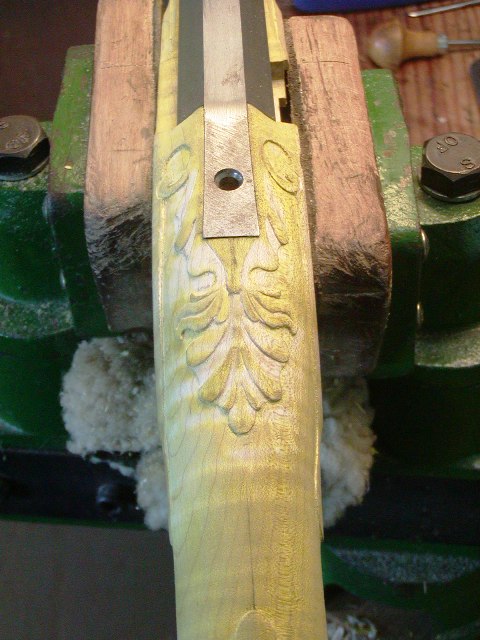
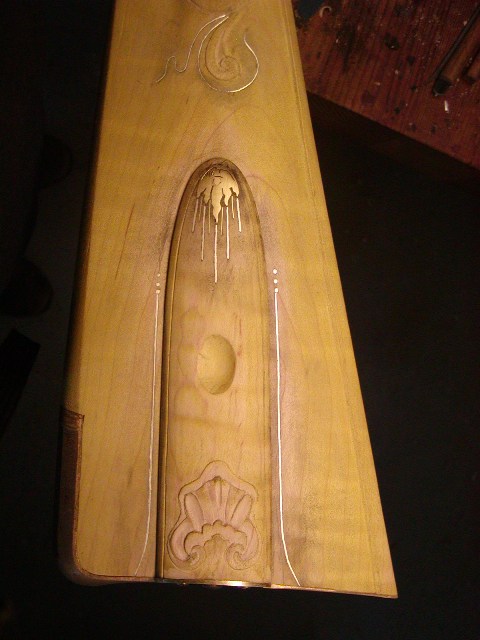
Here is a combination of asymmetric rococo scroll work combined with a folk art scene.
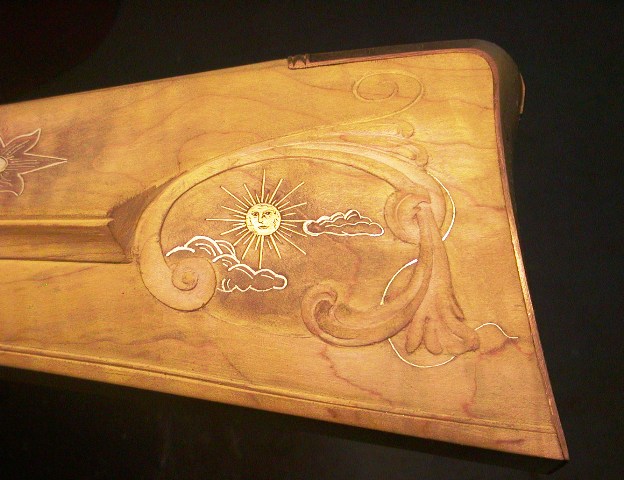
Here is the completed rifle.
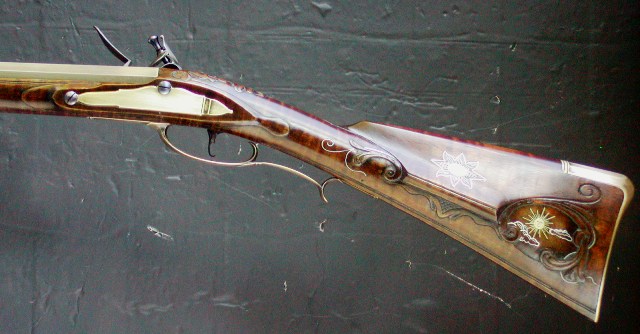
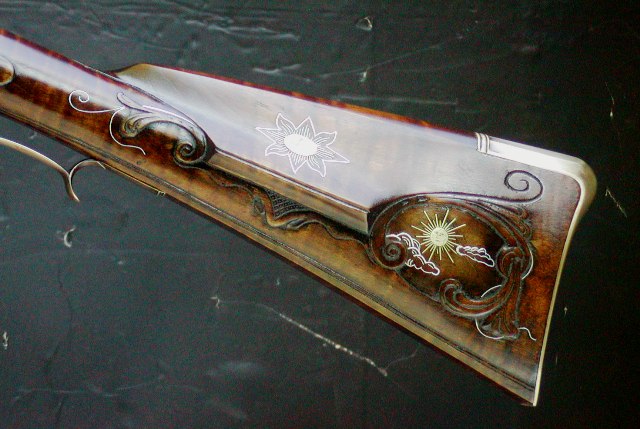
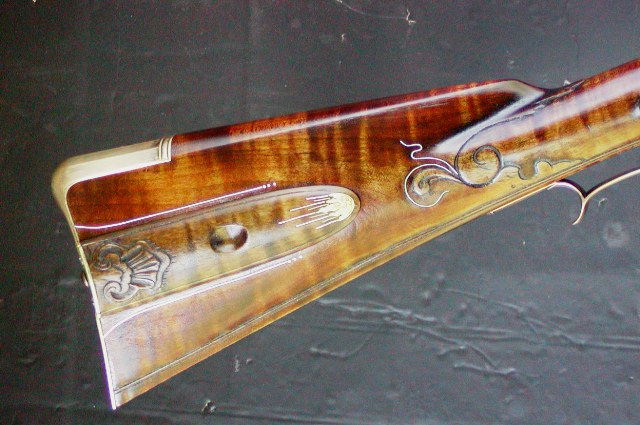
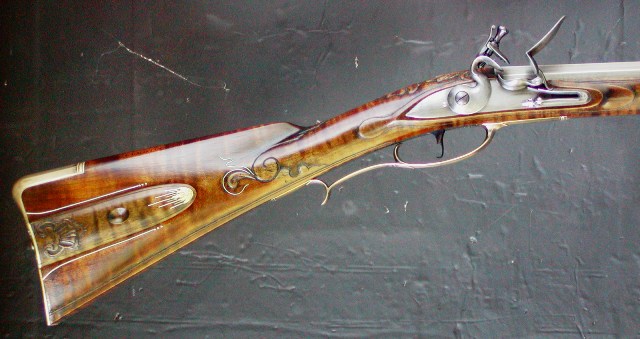
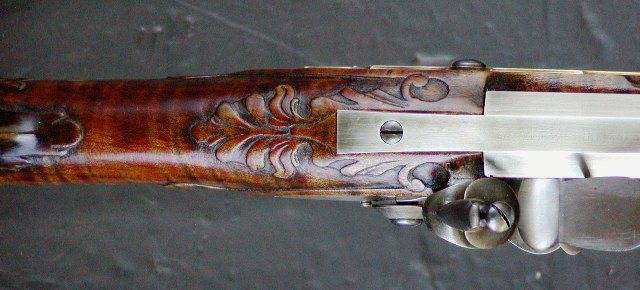
Here is a contemporary rifle I made that combines Baroque, rococo, and folk art. The combination is not unusual on 18th century American long rifles. Here is symmetrical Baroque style work around the barrel tang and on the patch box.


Here is a combination of asymmetric rococo scroll work combined with a folk art scene.

Here is the completed rifle.





Functionality, it's a device to kill with whatever is on the receiving end of it won't know if it is decorated or not. No point is paying more money just to look good. My best guess..It is an academic question, but I am wondering why German /American gun makers would have totally abandoned the decorative carving styles they learned in Germany. Colonial America tried to keep up with the styles of Europe.
Walaw717
40 Cal
- Joined
- Jan 31, 2022
- Messages
- 145
- Reaction score
- 294
Hi,
Here is a contemporary rifle I made that combines Baroque, rococo, and folk art. The combination is not unusual on 18th century American long rifles. Here is symmetrical Baroque style work around the barrel tang and on the patch box.


Here is a combination of asymmetric rococo scroll work combined with a folk art scene.

Here is the completed rifle.





Your work is always so beautiful Dave. All of this feedback is really helpful. My goal is to build a period piece and not a replica, something more reflective of me. These really help. I have been doing a lot of research while I await delivery. William
Walaw717
40 Cal
- Joined
- Jan 31, 2022
- Messages
- 145
- Reaction score
- 294
If you have a copy of "The Gunsmith of Grenville County" by Peter Alexander, it has a nice discussion on Baroque and Rococo styling on American flintlocks. He puts forth that on rifles, Rococo was taking over from Baroque in the 1750s and maybe the 1740s and lasted clear till the 1840s - much later than it faded out for other mediums.
Thanks I will look for it
Walaw717
40 Cal
- Joined
- Jan 31, 2022
- Messages
- 145
- Reaction score
- 294
Hi,
Here is a contemporary rifle I made that combines Baroque, rococo, and folk art. The combination is not unusual on 18th century American long rifles. Here is symmetrical Baroque style work around the barrel tang and on the patch box.


Here is a combination of asymmetric rococo scroll work combined with a folk art scene.

Here is the completed rifle.





A wee bit of masonic symbolism I think. Maybe I am seeing that because I was thinking about doing something masonic on my build. Seems appropriate for the period.
- Joined
- Aug 6, 2005
- Messages
- 7,144
- Reaction score
- 5,453
We have very few examples of rifles from the early to mid-1700s long rifles, and the rifles made now repeat the carving patterns of those few. Yet if one steps back to look at the baroque/rococo period, there was a great diversity of motifs in decorative carvings, especially in the examples of German Baroque in the Jaeger rifle. Modern flintlock long rifles have severely limited their palette and potential due to limited existing examples when they could be looking at a broader range of motifs. I know the temptation is to reproduce what already was, but by adding more baroque/rococo motifs, the new rifles could be a lot more exciting and individual in style.
Curious about everyone's thoughts on this topic.
Illustrations of your initial intentions would be very useful to enable people here to give you any kind of worthwhile response.
- Joined
- Aug 6, 2005
- Messages
- 7,144
- Reaction score
- 5,453
18th century hunting rifle View attachment 137092
From where, exactly?
Walaw717
40 Cal
- Joined
- Jan 31, 2022
- Messages
- 145
- Reaction score
- 294
From where, exactly?
A Jaeger on the internet. All my searching has been there so far.
- Joined
- Nov 26, 2005
- Messages
- 5,263
- Reaction score
- 11,113
Hi Walaw717,
I work very hard to understand the historical styles of decoration on firearms from the 16th to the early 19th centuries. My library is extensive and my scope of interest covers a wide range of regional styles and their changes over time. That includes carving but also stock architecture, engraving, and other decoration. For example, I avoid making American long rifles with Victorian carving or bank note engraving, or try to make them into high art guns in the European tradition. They never look right and always contrived to my eye. Anyway here are some examples. The first shows late mannerism and early French Baroque. The mannerism is expressed by the bizarre iconography. The impression is taken from guns by the Lebourgeoy family of Normandy, France during the early 17th century.
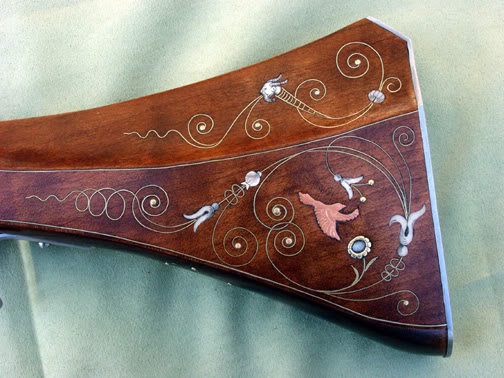
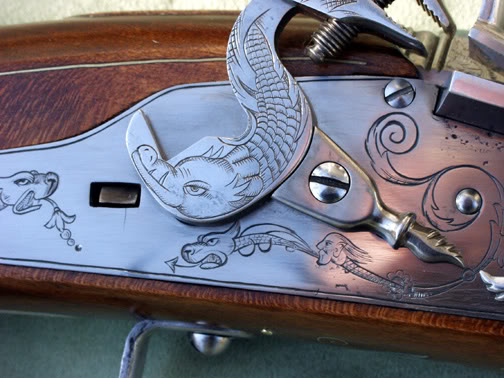
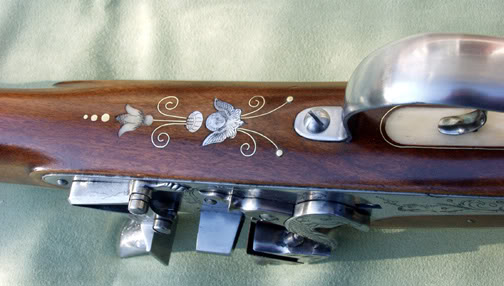
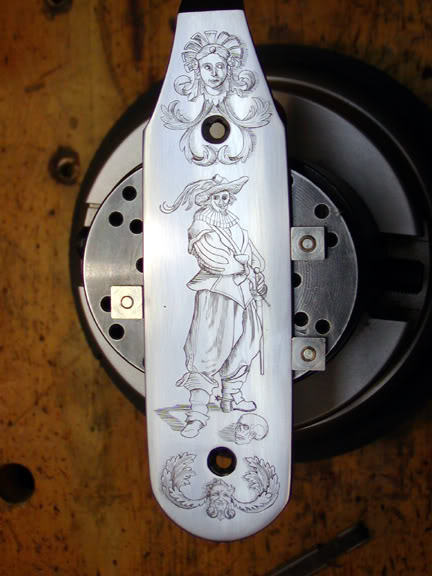
The next piece shows classic German interpretation of Baroque and some rococo styling but in a very provincial hand. It is great work on an American-made rifle probably from the 1750s or 1760s.
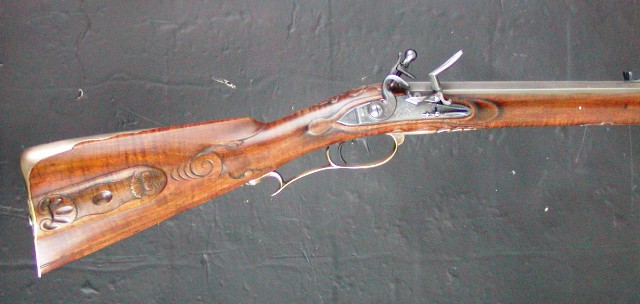
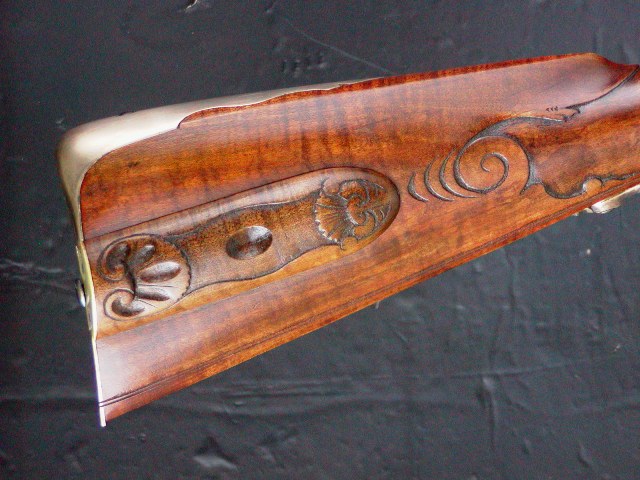
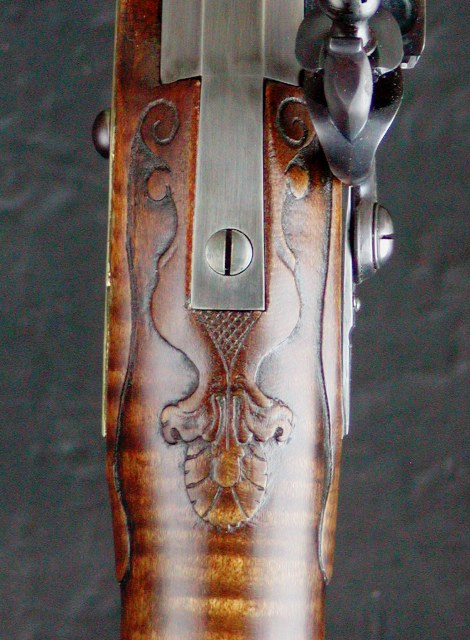
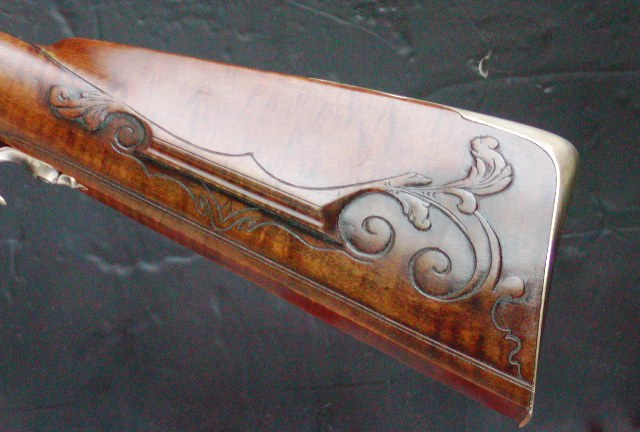
Now here is that Germanic rococo inspiration interpreted by later American makers and becoming less sophisticated and more influenced by folk art.
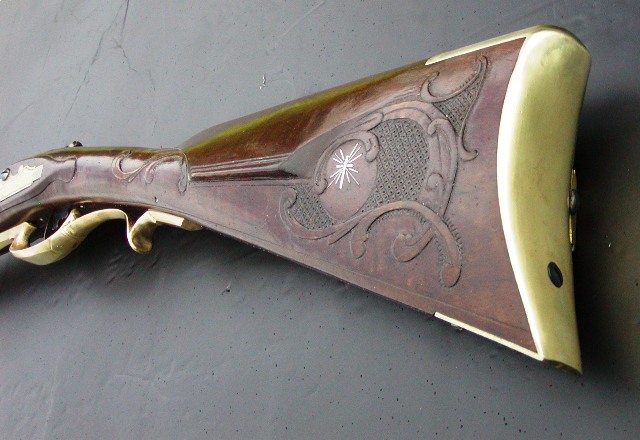
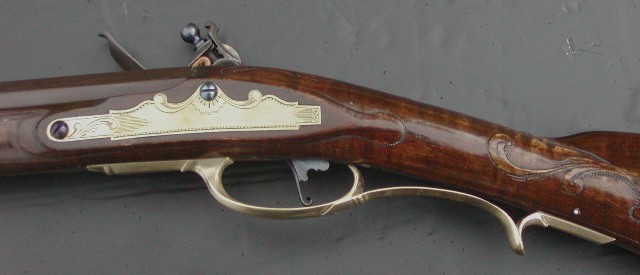
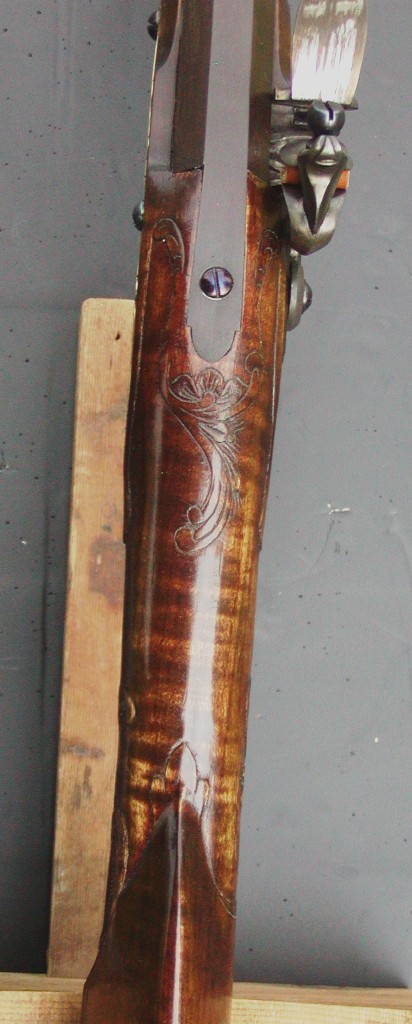
dave
I work very hard to understand the historical styles of decoration on firearms from the 16th to the early 19th centuries. My library is extensive and my scope of interest covers a wide range of regional styles and their changes over time. That includes carving but also stock architecture, engraving, and other decoration. For example, I avoid making American long rifles with Victorian carving or bank note engraving, or try to make them into high art guns in the European tradition. They never look right and always contrived to my eye. Anyway here are some examples. The first shows late mannerism and early French Baroque. The mannerism is expressed by the bizarre iconography. The impression is taken from guns by the Lebourgeoy family of Normandy, France during the early 17th century.




The next piece shows classic German interpretation of Baroque and some rococo styling but in a very provincial hand. It is great work on an American-made rifle probably from the 1750s or 1760s.




Now here is that Germanic rococo inspiration interpreted by later American makers and becoming less sophisticated and more influenced by folk art.



dave
Walaw717
40 Cal
- Joined
- Jan 31, 2022
- Messages
- 145
- Reaction score
- 294
Hi Walaw717,
I work very hard to understand the historical styles of decoration on firearms from the 16th to the early 19th centuries. My library is extensive and my scope of interest covers a wide range of regional styles and their changes over time. That includes carving but also stock architecture, engraving, and other decoration. For example, I avoid making American long rifles with Victorian carving or bank note engraving, or try to make them into high art guns in the European tradition. They never look right and always contrived to my eye. Anyway here are some examples. The first shows late mannerism and early French Baroque. The mannerism is expressed by the bizarre iconography. The impression is taken from guns by the Lebourgeoy family of Normandy, France during the early 17th century.




The next piece shows classic German interpretation of Baroque and some rococo styling but in a very provincial hand. It is great work on an American-made rifle probably from the 1750s or 1760s.




Now here is that Germanic rococo inspiration interpreted by later American makers and becoming less sophisticated and more influenced by folk art.



dave
Beautiful work Dave and helps clarify my question. And thinking. You are a master craftsman. And a great help.
- Joined
- May 6, 2014
- Messages
- 17,487
- Reaction score
- 16,593
A wee bit of masonic symbolism I think. Maybe I am seeing that because I was thinking about doing something masonic on my build. Seems appropriate for the period.
The Grand Lodge of Pennsylvania was founded in 1731 according to some sources. What I'm not sure of is how many Germanic Immigrants (who imported or made rifles) were Freemasons here, as Freemasonry didn't seem to take off in Germany until at least the late 1750's and mostly after the AWI. IOW, they did not have a strong following in Germany, so not too many immigrant German gunsmiths would have come here as Freemasons.
Still under "bespoke work" or custom orders as we say today, the customers could have drawn or shown Masonic Symbols to the gunsmiths to apply to their rifles and other guns. That and of course German Riflesmiths could become Freemasons after they got here.
Gus
Walaw717
40 Cal
- Joined
- Jan 31, 2022
- Messages
- 145
- Reaction score
- 294
The Grand Lodge of Pennsylvania was founded in 1731 according to some sources. What I'm not sure of is how many Germanic Immigrants (who imported or made rifles) were Freemasons here, as Freemasonry didn't seem to take off in Germany until at least the late 1750's and mostly after the AWI. IOW, they did not have a strong following in Germany, so not too many immigrant German gunsmiths would have come here as Freemasons.
Still under "bespoke work" or custom orders as we say today, the customers could have drawn or shown Masonic Symbols to the gunsmiths to apply to their rifles and other guns. That and of course German Riflesmiths could become Freemasons after they got here.
Gus
I was referring to some material on one of Dave's rifles above. Not in general.
- Joined
- May 6, 2014
- Messages
- 17,487
- Reaction score
- 16,593
I was referring to some material on one of Dave's rifles above. Not in general.
Ah, sorry.
Gus
Walaw717
40 Cal
- Joined
- Jan 31, 2022
- Messages
- 145
- Reaction score
- 294
Hi Walaw717,
I work very hard to understand the historical styles of decoration on firearms from the 16th to the early 19th centuries. My library is extensive and my scope of interest covers a wide range of regional styles and their changes over time. That includes carving but also stock architecture, engraving, and other decoration. For example, I avoid making American long rifles with Victorian carving or bank note engraving, or try to make them into high art guns in the European tradition. They never look right and always contrived to my eye. Anyway here are some examples. The first shows late mannerism and early French Baroque. The mannerism is expressed by the bizarre iconography. The impression is taken from guns by the Lebourgeoy family of Normandy, France during the early 17th century.




The next piece shows classic German interpretation of Baroque and some rococo styling but in a very provincial hand. It is great work on an American-made rifle probably from the 1750s or 1760s.




Now here is that Germanic rococo inspiration interpreted by later American makers and becoming less sophisticated and more influenced by folk art.



dave
Ah, sorry.
Gus
No problem. Just letting you know.
Walaw717
40 Cal
- Joined
- Jan 31, 2022
- Messages
- 145
- Reaction score
- 294
No problem. Just letting you know.
Your information on Mason's was interesting. By 1770 Mason's had spread to all the colonial states. I imagine their iconography showed on many rifles. The Sun, crescent moon and star are important symbols in masonry and at the time would have been explained away to non Mason's. I am familiar with the tradecraft.
- Joined
- May 6, 2014
- Messages
- 17,487
- Reaction score
- 16,593
Your information on Mason's was interesting. By 1770 Mason's had spread to all the colonial states. I imagine their iconography showed on many rifles. The Sun, crescent moon and star are important symbols in masonry and at the time would have been explained away to non Mason's. I am familiar with the tradecraft.
Brother/General/President George Washington received his Masonic degrees over a nine-month period in my adopted home town of Fredericksburg, VA. He was initiated an Entered Apprentice on November 4, 1752, passed to Fellow Craft on March 3, 1753, and raised to Master Mason on August 4, 1753. This all after the Lodge had only been opened a year or two.
He served as Lt Col Commanding the VA provincial regiment in Winchester, Va from 1755 to December 1758. Now there were other Freemasons in the area as well as Riflesmiths, but no lodge until 1768. I had hoped to find a known Freemason Riflesmith that early in Lodge records while he was there during the FIW, but to no avail.
Gus
Similar threads
- Replies
- 21
- Views
- 2K
- Replies
- 60
- Views
- 7K
- Replies
- 19
- Views
- 3K
- Replies
- 0
- Views
- 3K




